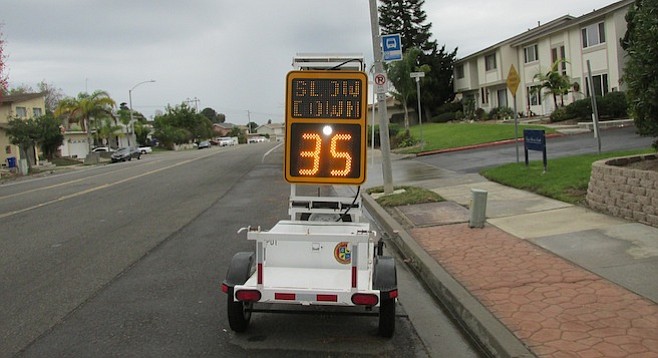 Facebook
Facebook
 X
X
 Instagram
Instagram
 TikTok
TikTok
 Youtube
Youtube

It has been one month since the City of Oceanside turned off their red-light cameras. Yet, the camera units at four Oceanside intersections still flash and take pictures, and the signs are still posted.
“The public still perceives them as operational, so it will be about four to six months before we may see any difference [running red lights],” said Oceanside police traffic Sgt. Rich Schickel. He explained it’s hard to enforce red-light runners from an officer’s standpoint. There aren’t many areas around busy intersections where officers can safely sit and watch for violators.
The main intersection the motorcycle officers might focus on may be southbound El Camino Real, turning onto westbound Vista Way. The large Discount Tire parking lot offers the officers a safe spot to sit and wait. Otherwise, in most areas of the city, Schickel indicated, red-light tickets would be given, as they’ve always been, when officers are moving with traffic and witness the violation.
Oceanside Police Dept. spokesperson Lt. Leonard Cosby said the city is leaving the cameras up for now, although violations have not been enforced since December 1. “We receive other information from them, like pictures of robbery suspects and stolen cars,” he said.
Oceanside has another tool in its speeding-enforcement arsenal — this one to slow down speeders. In 2014, their mobile data speed-limit signboard, showing the speed limit and the speeds of vehicles, had been posted around the city in 43 locations. Speeding motorists see their speed flashing and a series of bright flashes, coming from, one would think, a camera.
During the holidays, the unit was posted on the downhill side of Lake Drive. The four-lane road, southbound at the top of the summit, is posted at 50 miles per hour. As the road winds down through an older neighborhood, it is reduced to two lanes and posted at 30 miles per hour. The unit works: cars were seen slowing down rather quickly when the supposed camera started to flash. But, just like the red-light cameras that are no longer resulting in citations, the fake speed camera does not record anything other than overall speed data for traffic engineers.
Unlike other states, it is illegal in California for any agency to use photo speed enforcement cameras. Other cities have shut off their red-light cameras due to the program costing more than the cameras generated in fines. Carlsbad, Del Mar, Encinitas, San Marcos, Solana Beach, and Vista still use red-light cameras. The total cost in fines, court fees, and traffic school is around $600. Due to budget constraints, traffic commissioners have been advised by their presiding judges not to lower red-light fines for violators who show up in court.
In 2001, California adopted Vehicle Code Section 21455.6, which outlaws the use of photo speed enforcement. Arizona has shut off their freeway speed cameras, usually found in rural areas, after shots were fired into mobile roadside equipment around the state.


It has been one month since the City of Oceanside turned off their red-light cameras. Yet, the camera units at four Oceanside intersections still flash and take pictures, and the signs are still posted.
“The public still perceives them as operational, so it will be about four to six months before we may see any difference [running red lights],” said Oceanside police traffic Sgt. Rich Schickel. He explained it’s hard to enforce red-light runners from an officer’s standpoint. There aren’t many areas around busy intersections where officers can safely sit and watch for violators.
The main intersection the motorcycle officers might focus on may be southbound El Camino Real, turning onto westbound Vista Way. The large Discount Tire parking lot offers the officers a safe spot to sit and wait. Otherwise, in most areas of the city, Schickel indicated, red-light tickets would be given, as they’ve always been, when officers are moving with traffic and witness the violation.
Oceanside Police Dept. spokesperson Lt. Leonard Cosby said the city is leaving the cameras up for now, although violations have not been enforced since December 1. “We receive other information from them, like pictures of robbery suspects and stolen cars,” he said.
Oceanside has another tool in its speeding-enforcement arsenal — this one to slow down speeders. In 2014, their mobile data speed-limit signboard, showing the speed limit and the speeds of vehicles, had been posted around the city in 43 locations. Speeding motorists see their speed flashing and a series of bright flashes, coming from, one would think, a camera.
During the holidays, the unit was posted on the downhill side of Lake Drive. The four-lane road, southbound at the top of the summit, is posted at 50 miles per hour. As the road winds down through an older neighborhood, it is reduced to two lanes and posted at 30 miles per hour. The unit works: cars were seen slowing down rather quickly when the supposed camera started to flash. But, just like the red-light cameras that are no longer resulting in citations, the fake speed camera does not record anything other than overall speed data for traffic engineers.
Unlike other states, it is illegal in California for any agency to use photo speed enforcement cameras. Other cities have shut off their red-light cameras due to the program costing more than the cameras generated in fines. Carlsbad, Del Mar, Encinitas, San Marcos, Solana Beach, and Vista still use red-light cameras. The total cost in fines, court fees, and traffic school is around $600. Due to budget constraints, traffic commissioners have been advised by their presiding judges not to lower red-light fines for violators who show up in court.
In 2001, California adopted Vehicle Code Section 21455.6, which outlaws the use of photo speed enforcement. Arizona has shut off their freeway speed cameras, usually found in rural areas, after shots were fired into mobile roadside equipment around the state.
Comments